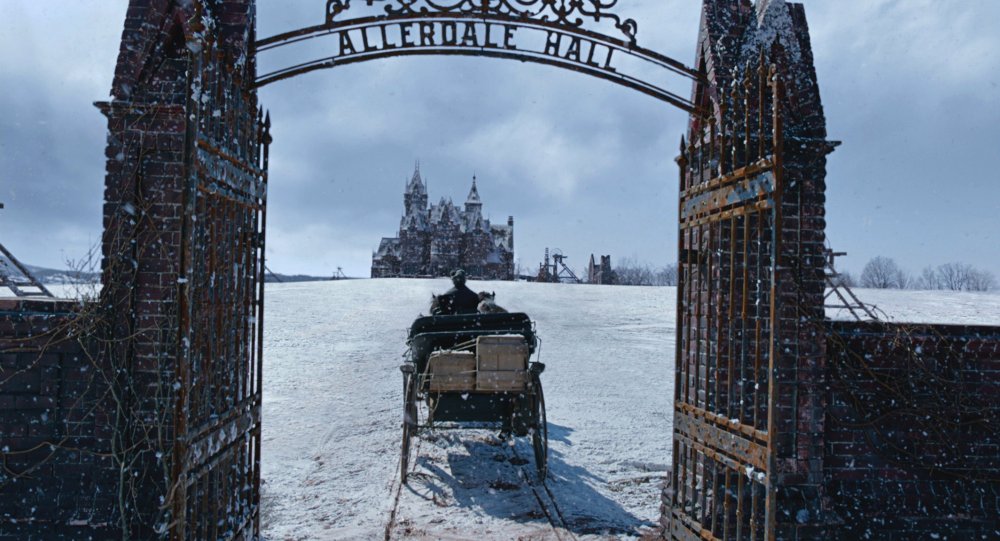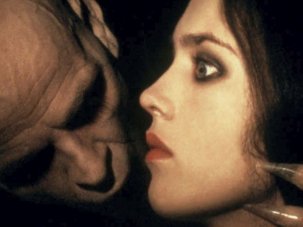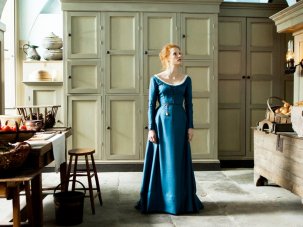Spoiler alert: this review discusses plot revelations including the finale.
Like Guillermo del Toro’s The Devil’s Backbone (2001) and Pan’s Labyrinth (2006), the cavernous, ruined mansion that is the visual centrepiece of Crimson Peak is genuinely haunted – with clutching, bloody ghosts that might be kin to the spook in the del Toro-produced Mama (2013) and are CGI models built around the frame of the director’s favoured monster man Doug Jones – but the real horrors come from malicious living human beings.
USA 2015
Certificate 15 118m 39s
Director Guillermo del Toro
Cast
Edith Cushing Mia Wasikowska
Lucille Sharpe Jessica Chastain
Thomas Sharpe Tom Hiddleston
[1.85:1]
UK release date 16 October 2015
Distributor Universal Pictures International UK & Eire
► Trailer
Shorn of the Spanish Civil War setting (and Spanish-language dialogue) of the earlier films, Crimson Peak still has its element of vitriolic social analysis. Early on, the heroine’s practical, bearded, self-made father (Jim Beaver), perhaps the only sympathetic banker depicted in a 21st century film, feels the aristocratic petitioner’s soft hands before turning him down for a loan. Dismissing the model of the steam excavator Sharpe (Tom Hiddleston) wants to invent as a ‘toy’, Cushing sees the weak-blooded swain as infantile and it later turns out that he has indeed spent a great deal of time manufacturing odd, creepy period playthings for his smothering sister (Jessica Chastain).
Strangely, this boyish streak is the thing del Toro most likes about his supposedly fatal man and Hiddleston plays Sharpe’s squirming indecision to perfection. In the end, even Sharpe’s mad sister agrees with Cushing and entreats him to get his hands dirty by committing one of the murders she has been getting away with to support their mad ménage.
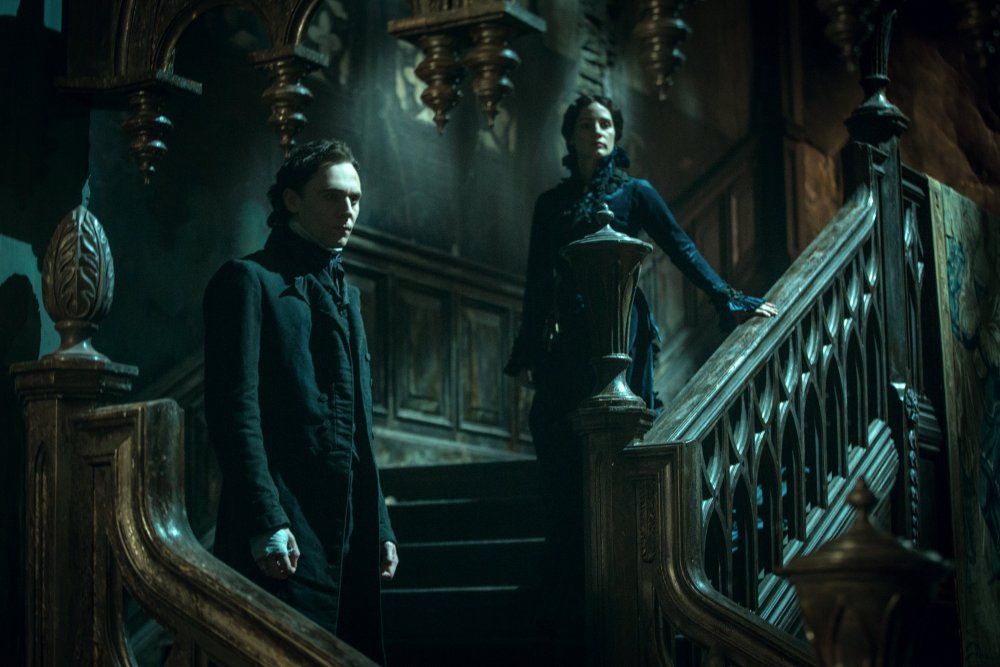
Crimson Peak (2015)
Del Toro has explained that he sees Crimson Peak as a gothic romance rather than a horror film. Like Daphne du Maurier in Rebecca, del Toro and co-scenarist Matthew Robbins scramble elements from Jane Eyre (which Charlotte Brontë deliberately repurposed from Anne Radcliffe and other full-blooded gothic practitioners): a vast and many-storied old house far removed from other human habitation, a mysterious earlier marriage (here, in Bluebeard fashion, a clutch of them – though only the last Lady Sharpe left a ghost along with a collection of incriminating wax cylinders and photographs), a strangely passive master in the power of a sinister secondary woman, an initially timid yet resolute heroine who gets to the bottom of it all and survives dire peril. All that’s missing is a climactic conflagration, as if del Toro were so in love with Allerton Hall that he can’t bear to go the full, approved Roger Corman House of Usher route and expunge the past at the climax by burning down the house.
The real strength of Crimson Peak is its magnificent ruin, where leaves and snow flutter down through a gaping hole in the ceiling, a rickety cage lift plunges to a basement whose walls drip with disgusting red clay, the particular composition of the soil stains the snow the colour of blood (hence the title, which has a vaguely menstrual connotation) and each tiny detail of art direction and set decoration adds to an environment the camera loves to explore. To preserve this, the demented Lucille commits multiple murders – bludgeoning heads against solid sinks or stirring poison into the porridge – and the true gothic passion of the film comes not in the whirl of loves and jealousies around the heroine but in the villain’s resolute commitment to her horrific home.
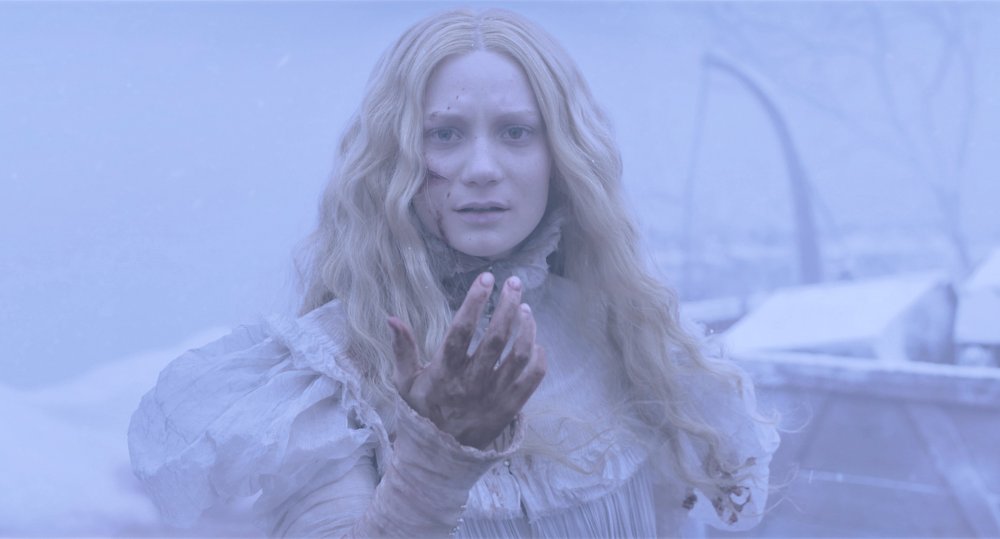
Crimson Peak (2015)
Mia Wasikowska, who has already played Alice in Wonderland and Jane Eyre, is a post-modern gothic heroine, who has already channelled her own Sixth Sense visions into a novel in progress (a publisher suggests adding a love story) and is required to save herself and her would-be rescuer by getting into a final girl vs psycho-killer film confrontation with her nemesis sister-in-law/rival at the finale. Echoing the razor-cut mouth of Pan’s Labyrinth, the tangle of conflicts is played out with horribly intimate wounds – Lucille stabs the hero in the armpit and her brother in the face, while Edith fights back with a deadly pen (a gift from her father) and finishes the job with a shovel and a quip (“I heard you the first time”) that seems more like a coup de grace from an ’80s slasher film (specifically, Psycho II, 1983) than a 19th century gothic.
There are a few infelicities of dialogue – Edith points out Sharpe’s hand-made shoes in an era when everyone’s were – and the whole contraption of plot and setting is so intricate and symbol-studded (the house is full of butterfly-killing moths which flap even in mid-winter) that the conventional tortured romance seems a touch rote. This has shocks, but few scares – after all, in del Toro’s world, ghosts may look alarming but they are basically our friends. Nevertheless, this is a rich essay in the form, which takes care to evoke even the lighting cues of vintage Roger Corman or Mario Bava in the service of a rattling good melodrama.
In the November 2015 issue of Sight & Sound
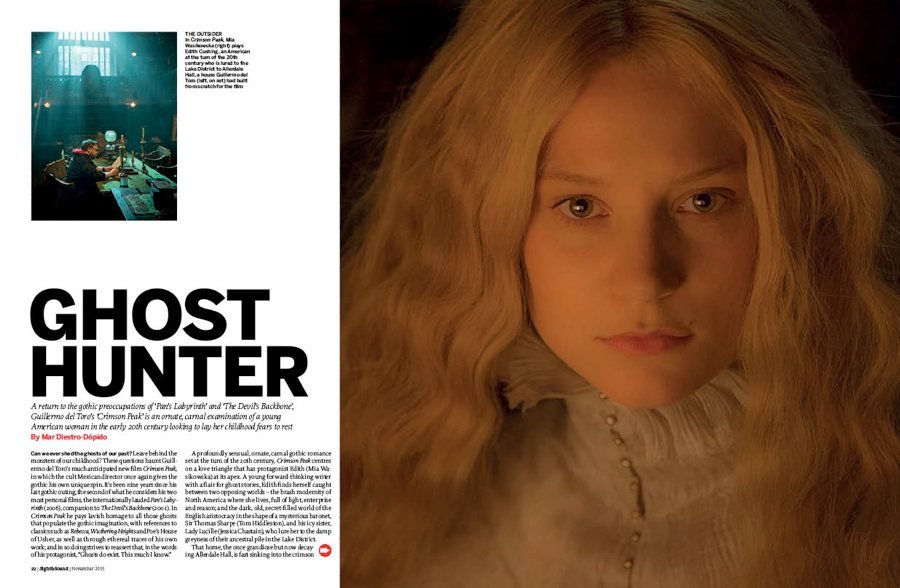
Ghost Hunter
A return to the gothic preoccupations of Pan’s Labyrinth and The Devil’s Backbone, Guillermo del Toro’s Crimson Peak is an ornate, carnal examination of a young American woman in the early 20th century looking to lay her childhood fears to rest. By Mar Diestro-Dópido.
See also:
☞ See Guillermo del Toro’s top ten films in our 2012 Greatest Films of All Time poll
☞ Read Guillermo del Toro’s essay Lessons in Darkness in our August 2012 issue or in the BFI compendium 39 Steps to the Genius of Hitchcock.
-
Sight & Sound: the November 2015 issue

Guillermo del Toro’s gothic Crimson Peak, Andrei Tarkovsky’s path-forging screen poetry and Yorgos Lanthimos’s starry social...
-
The Digital Edition and Archive quick link
Log in here to your digital edition and archive subscription, take a look at the packages on offer and buy a subscription.




